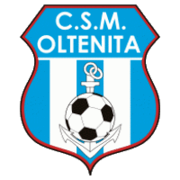CSM Oltenița
 | |||
| Full name | Club Sportiv Municipal Oltenița | ||
|---|---|---|---|
| Nickname(s) |
Napoletanii Oltenițenii (The People from Oltenița) | ||
| Short name | Oltenița | ||
| Founded |
1948 as Șantierul Naval Oltenița 2012 as CSM Oltenița | ||
| Ground | Municipal | ||
| Capacity | 2,500 | ||
| Owner | Oltenița Municipality | ||
| Chairman | Iulian Cudalbu | ||
| Manager | Gabriel Radu | ||
| League | Liga III | ||
| 2017–18 | Liga III, Seria II, 10th | ||
| Website | Club website | ||
|
| |||
Club Sportiv Municipal Oltenița, commonly known as CSM Oltenița, or simply Oltenița (Romanian pronunciation: [olˈtenit͡sa]), is a professional Romanian football club based in Oltenița, Călărași County.
The team was founded as Șantierul Naval Oltenița in 1948 and played between 1965 and 1992 in the Liga II and Liga III. After 1992 the team had only sporadic appearances in the third league, before being declared bankrupt at the end of the 2004–05 season. For 7 years football has disappeared from the city, and the stadium has also become a ruin. In 2011 the renovations of the stadium started and after one year the club was refounded, this time as CSM Oltenița.
History
CSM Oltenița was founded in 1948 as Șantierul Naval Oltenița (also known as ȘN Oltenița or SNO) and promoted for the first time in the Liga III at the end of the 1964–65 season. For five years ȘN Oltenița played at this level, until its promotion to Divizia B, at the end of the 1969–70 season.[1] Strongly supported by the Oltenița shipyard the club had good results and at the end of the 1971–72 season occupied the 3rd place (best ranking in its entire history).[2] In the following seasons the club no longer succeeded in approaching this performance: 1972–73 – 6th, 1973–74 – 13th, 1974–75 – 9th, 1975–76 – 13th, then culminating with a 17th place and a relegation at the end of the 1976–77 season. After one season, the club from the left bank of the Argeș River promoted again, but it would only last a season before returning to the third league, where it would remain. In 1992 after the Romanian Revolution and fall of the communism in Romania, Oltenița shipyard, which was an institution of the state, has begun to face growing financial problems, which has also shifted to the football team.
In 1992 Unirea Tricolor București (not to be confused with the original club Unirea Tricolor București, which was dissolved in 1958) was moved from Bucharest to Oltenița merging with ISCIP Ulmeni and ȘN Oltenița. The new entity was named Unirea Tricolor Oltenița, then Navol Unirea Oltenița.[3] After two seasons, Unirea Tricolor and ȘN Oltenița split up, Unirea Tricolor moved back to Bucharest and maintained the Divizia C place while ȘN Oltenița was renamed as Navol Oltenița (the new name of the Oltenița shipyard) and enrolled in the Divizia D.[4] Navol promoted after only one season and remained in the Divizia C until 1999, then promoting again only in 2004. As the shipyard's support had disappeared because of the serious problems it faced, Navol has withdrawn at the end of the season due to lack of funds, the shipyard was declared bankrupt a year later. After this followed the darkest period in the history of football from Oltenița, a period of seven years in which the club remained just a memory and the stadium has become a ruin.[5]
| Name [6] | Period |
| Șantierul Naval Oltenița | 1948–1992 |
| Unirea Tricolor Oltenița | 1992–1993 |
| Navol Unirea Oltenița | 1993–1994 |
| Navol Oltenița | 1994–2005 |
| CSM Oltenița | 2012–present |
In 2011 the stadium was renovated and in 2012 the football club was refounded as CSM Oltenița.[7] The team returned in the Liga III at the end of the 2014–15 season when they won Liga IV, Călărași County group.
Ground
CSM Oltenița plays its home matches on Municipal Stadium from Oltenița, a stadium with a capacity of 2,500.[8] The stadium had in the past a capacity of 10,000 people, but after the period in which was abandoned much of it was irreparably destroyed. In 2011 the stadium was revived, but the capacity was reduced at only 2,500 and from 2014 was also bought by Municipality of Oltenița from the company that took over the assets of the Oltenița shipyard after its bankruptcy.[9]
Honours
- Liga III
- Winners (2): 1969–70, 1977–78
- Runners-up (1): 1982–83
- Liga IV – Călărași County
- Winners (4): 1964–65, 1995–96, 2003–04, 2014–15
Other performances
- Appearances in Liga II: 8
- Best finish in Liga II: 3rd place in the 1971–72
Current squad
- As of 16 September 2018
Note: Flags indicate national team as defined under FIFA eligibility rules. Players may hold more than one non-FIFA nationality.
|
|
Club officials
References
- ↑ "Clasamente Divizia C" [Divizia C tables]. romaniansoccer.ro. Retrieved 2 September 2018.
- ↑ "Clasamente Divizia B" [Divizia B tables]. romaniansoccer.ro. Retrieved 2 September 2018.
- ↑ "Sezonul 1992–93" [Season 1992–93]. romaniansoccer.ro. Retrieved 2 September 2018.
- ↑ "Sezonul 1994–95" [Season 1993–95]. romaniansoccer.ro. Retrieved 2 September 2018.
- ↑ "Olteniţa, tot fără fotbal!" [Season 1993–95]. liga2.prosport.ro. Retrieved 2 September 2018.
- ↑ "Evolutia denumirilor echipelor de-a lungul anilor" [Evolution of team names over the years]. romaniansoccer.ro. Retrieved 2 September 2018.
- ↑ "La Olteniţa reînvie spiritul fotbalului de altă dată!" [Oltenita revives the spirit of football once again!]. ligab.gsp.ro. Retrieved 2 September 2018.
- ↑ "Surle și trâmbițe pe stadion, la meciul dintre CSM Oltenița și Înainte Modelu". olteniteanul.ro. Retrieved 2 September 2018.
- ↑ "Arena din Oltenița intrat in proprietatea municipiului" [The arena from Oltenița entered in the property of the municipality]. arenamedia.ro. Retrieved 2 September 2018.